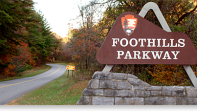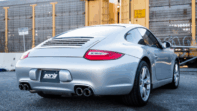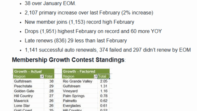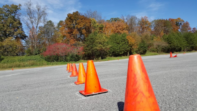These tips and details were excerpted from the National PCA Autocross Defined page, so you can check there for all the latest details.
At the Autocross
A course will be setup on a large parking lot. Soft traffic pylons will be used to form a course consisting of turns, slaloms, and straight areas. Arrive early — see what goes on, volunteer to get involved!
When you arrive
Prepare your car
Remove all loose items from your car — floor mats, driver’s carpet, coffee cups, etc. Check tire pressure and chalk your tires.
Register
- Register wherever that is set up
- Select a run group and get a car number
- Complete waiver and registration form
- Sign up for a work station
Technical Inspection
- Drive car to Tech Inspection (or, they may find you)
- Give registration form to Inspector
- Car will be inspected for safety
- Put your car number and class on window as directed
At the Driver’s Meeting
Check the course map at the timing trailer and attend the driver’s meeting where you will learn about the course:
- Safety
- Danger Zones
- Tight Corners
- Wet or Oil Spots
- Uneven or Rough Pavement
- Flagging and Corner Worker Instructions
- Availibilty of Instructors
Course Walk
Otherwise known as walking the line – walk the course with an experienced driver.
- Check for surface bumps, loose gravel and stones, uneven pavement, joints, etc.
- You will be given between 10 and 20 minutes to walk the course between each run session. To ‘stay the course,’ you must first stay on course.
- The first problem that confronts every autocrosser is staying on course. So the first step is learn where it goes.
- Study the course map, and then walk the course. If no map is provided, make your own
- Walk the course at every opportunity…and take your time. Avoid following a crowd that blocks your view.
- Walk the line you plan to drive as if you were sitting in the driver’s seat.
- Stop and study difficult or optional sections of the course to plan your line. Observe other drivers; note where they have difficulty — hitting pylons or staying on course. Move around the course to observe problem areas from different locations.
- Having completed this step, decide how to go. How to go calls for a plan. And remember, an imperfect plan is always better than no plan at all.
- The question autocrossers most often ask is, “How do I determine the best line or path around the course?”
- To begin with, concentrating only on determining the best line in autocrossing may be compared to slalom skiing. In an autocross, we are concerned with three things: time, distance and speed.
- The formula time = distance / speed expresses the relationship of three factors. We must determine how to drive the course in the least possible time. In order to do this, the path chosen should offer the shortest distance and permit the greatest speed. As the formula illustrates, time can be made smaller by either decreasing the distance or increasing the speed…or better yet, both. Many times it becomes impossible to drive at the highest speed over the shortest distance. When this occurs, the best path is a compromise somewhere between the two extremes.
Once the Competition Starts
- Watch other drivers:
- What line are they driving?
- Where are the breaking points?
- Where are the shifting points (up and down)?
Now it’s your turn
- Bring your car to staging area
- Proceed to start line
- Check your seat belt
- Make sure all loose objects are out of the car
- Turn the rear view mirror away from view
- Focus your thoughts on how you want to drive & the course
Starter gives the OK!
- Start sharp
- Look ahead at gates & know where you want to be
- Remember when to brake and shift
If you should spin
- BOTH FEET IN – depress the clutch and brake fully
- Look for corner workers to re-start you
- Finish the course
If you see a Red Flag
- Quickly come to a complete stop
- Look for corner workers to re-start you
Drive the First Run at Reduced Throttle
- Learn to stay on course
- Drive a good line
- Drive S M O O T H L Y
- Have a good time!
Sample Classification System
Stock
Cars must have been series produced with normal road touring equipment capable of being licensed for normal road use in the United States, and normally sold and delivered through manufacturer’s retail sales outlets in the United States.
Allowable Modifications
- Accessories, guages, indicators, lights and other appearance modifications which have no effect on performance and/or handling and do not materially reduce the weight of the car are permitted.
- Alternate steering wheels are allowed provided the outside diameter is not changed by more than one inch from the standard size.
- Any tire which is O.E.M. on a car eligible for Stock Category may be used. Non allowable tires are: Hoosier (all), M&H (all), McCreary, and Mickey Thompson Indy Profile and Indy Profile S/S.
- Any type of wheel may be used provided: It is the same width and diameter as stock and it does not have an offset more than +/- .25 inch from the standard wheel for the car. Wheel spacers are not allowed
- Any shock absorber may be substituted provided the number, type, system of attachment points are not altered. Suspension geometry and range travel may not be altered.
- Substitution, addition or removal of any front anti-roll bars is permitted
- The make of spark plugs, points ignition, coil, and high tension wires is free.
- Air filters may be removed, however, no other components of the air induction system may be removed, replaced, or modified.
Street Prepared
Equipment and/or modifications may be exchanged between different years and models of a vehicle if the item is standard on the year/model from which it was taken. The updated/backdated part of the part to which it is to be attached may not be altered, modified, machined or otherwise changed to facilitate the updating/backdating allowance. The updating/ backdating of engines, transmissions or transaxles must be done as a unit, component parts of these units may not be interchanged.
- Fenders and bumpers may be modified for tire clearance
- Any fully padded and upholstered front seat may be used
- Any steering wheel may be used
- Aerodynamic devices are permitted, however, wings are not allowed.
- Wheels of any diameter, width, or offset may be used.
- Shock absorber bump stops may be altered or removed.
- Any anti-sway bar is permitted.
- Suspension bushings may be replaced with bushings of any material (except metal) as long as they fit in the original location.
- Relocation of battery or batteries is permitted.
- Carbs., fuel injection, intercoolers and intake manifolds are unrestricted. Turbos may not be changed or modified.
- Limited Slip differentials are permitted.
Prepared
- Removal of glass and/or headlight, front parking or front signal light assemblies, lenses and bulbs is not required. Operating tail/stop lights are required.
- Mirrors are not required
- Grills may be removed
- Any fuel tank may be used
- Passenger seats are not required
- Driver and Passenger door glass may be removed
- Floor covering and all interior trim may be removed
- Component parts of the body may be lightened or replaced by ones of alternative materials.
- Roll bars and roll cages may be added.
Modified
- Interiors may be gutted.
- Suspension systems and wheels are free.
- Windscreen, side mirrors and tail/stop lights are not required.
Driving Techniques
Proper Sitting Positions
Adjust the driver’s seat so that your elbows are slightly bent while your hands are on the steering wheel either at the 10 and 2 o’clock position or the 9 and 3 o’clock position. Now your leg position should be adjusted so that your legs stay slightly bent even when you operate the clutch and/or the brake pedal. You do not want to over-extend or straighten your legs when you operate the various pedals. The seat back (rake) should be adjusted so that you can put the bottom of your wrists on the top of the steering wheel without stretching to do so.
NOTE: Because of your body structure or that you are very tall, you may have to compromise your position to allow you to sit in the seat with your helmet on and not hit your head on the roof/headliner of your car. If anything adjust the rake of the seat more so than the leg position.
If possible, obtain and use a four or five point harness. If using your standard shoulder/lap belt, try and adjust it tight enough so that you will not move around in your seat. This will enable you to concentrate more on your driving and less on trying to stay in your seat.
Adjust your left side view mirror and your rear view mirror so that you can see that traffic that may come up behind you. Your instructor should adjust the right side view mirror for his view so that he can also watch oncomming traffic.
Try and keep your head as erect as possible, that is, in the same plane as the car is in. Leaning your head into the turn will not make the car handle any better. What will happen is that you will receive a distorted view and distorted inputs through your eyes to your brain, thus in turn affecting your driving skills.
Steering Techniques
Keep both hands on the steering wheel at all times, except at the start and shifting.
Position your hands on the steering wheel at either the 10 and 2 o’clock positions or 9 and 3 o’clock positions on the wheel.
For most of your steering inputs, you will not have to adjust your hand positions. However on some courses that have very tight turns you may want to use what we term the “Steering Shuffle” routine. This will enable you to feed the wheel from hand to hand without taking either hand off of the steering wheel. First imagine that there is a vertical line through the steering wheel at 12 and 6 o’clock. The left hand stays on the left side of the wheel and the right hand stays on the right side. To turn right, slide the right hand up to the top of the steering wheel at 12 o’clock then pull the wheel down to the 6 o’clock position, meeting the right hand with the left hand which has slid around the steering wheel to that position. To continue to turn the wheel, the left hand will now pull the wheel to the 12 o’clock position, and so on. To turn left, the left hand begins the process by starting to pull the wheel from the 12 o’clock position down the left side to the 6 o’clock position where the right hand will meet it and continue the arc to the left. Remember: you use this process to turn into a corner and to turn out of the corner, so you turn in and you turn out. Don’t let the steering wheel loose in your hands when coming out of a turn then grab it when you think it is straight. You will only be playing a guessing game. Steer in, steer out. Also, most of the movement that you will do with this method will go beyond the 9 and 3 o’clock positions on the steering wheel. The more you practice this method, the easier it will work, eventually it will be an automatic process. As you exercise the procedure, you will appear to be moving the wheel slowly, but deliberately. Slow down and you will go faster!
Heel-and-Toe
This is what you need to use to make smooth shift changes when going from a higher gear to a lower gear and at the same time braking. The first question you may ask is, “There are three pedals, but I only have two feet?” With this technique, which you will use at the end of the brake zone, it will enable you to continue your braking and to “blip” the accelerator (throttle) to get your engine’s RPM’s up for that SMOOTH shift when you let out the clutch and engage to accelerate through the apex and out of the turn.
There are three basic positions to accomplish this task:
- Ball of the right foot on the brake, heel on the bottom or middle of the accelerator
- Ball of the right foot on the accelerator, heel on the brake.
- The left side of the right foot on the brake, and the right side of the same foot on the accelerator — rolling the foot to the right side to blip the accelerator.
There is no set position that is most correct, which one works is the one that works the easiest and the best for you. And also depends upon your pedal cluster and how you can angle your feet.
Let me talk you through the process. You are accelerating down a long straight on the course and will be approaching a turn. To proceed through the turn properly, you will need to be in a lower gear. As you approach the turn, you brake. As you near the end of the brake zone, while still maintaining the braking of the car, you push in the clutch with your left foot, then move your right foot to blip the accelerator while you are still continuing the braking procedure. Now with the clutch still in, you shift from the higher gear to the lower gear, then let out the clutch, at the same time, bliping the throttle several times to maintain the higher engine RPM. As the clutch is engaged and the engine’s RPM’s meet the transmission RPM’s this shift procedure will be smooth. This will eliminate the jolts you may have felt in the past when the clutch was engaged. It keeps the attitude of the vehicle stable, the suspension stable, and your driving line SMOOTH.
Remember, this is a technique that should be practiced at slow speeds, in a parking lot, etc., until you have the routine down smoothly and you do not have to concentrate on working it. It is an important technique which you will use whether you are driving on the roadcourse, autocrossing or just everyday street driving.
Tips and Guidelines
General Rules
- Never brake in a corner unless you are an advanced driver
- Enter slow, exit fast
- Use a consistent, comfortable braking point
- Maximize exit speed by getting on the power sooner, before increasing entry speed into the corner.
The Line
- The Line is the route around a course and through its corners which yields the lowest elapsed time.
- In a corner, it’s the broadest arc that maximizes speed, given “g” as a constant in V(2) = 15 gr
- The Line and the geometry of the edges of the pavement are usually different.
- There is only one “line”, but some people may have slight variations.
- Different cars require different approaches to stay on The Line
- The most important corners are those leading to the longest straights.
Apex
The geometric apex is at the point where the bisection of the angle of the tangent lines drawn from the turn entry and turn exit crosses the inside edge of the track. The driven apex is the point on the inside of the track that the driver chooses (hopefully intentionally) to divide the turn. If before the geometric apex, it is termed an Early Apex. If after the geometric apex, it is termed a late apex. In general: “late apex = safe apex.”
Vision
- Eyes up – don’t look at the nose of the car.
- Where you’re looking is where you’re going.
- Look through a corner and beyond, expand your field of vision.
- When exiting a corner look ahead for:
(1) Flag Station and Corner Workers
(2) Traffic – all around
(3) Mirrors, guages, etc. - Do not follow blindly.
- Do not fixate on the cones.
Vision is the most important element of high performance driving
Gate Summary
Start Gate
- Line up on start line as directed
- Start when ready after starter’s signal
- Break timing beam at highest attainable speed.
Box
- Boxes are usually driven through at least twice.
- The course line crosses within the box.
Decision Gate
- Locate decision gates and memorize sequence of direction changes when passing through gate, ie: 1st time, turn left, 2nd time right, etc.
- Decision gate sequence can be in any order or combination of that shown above.
Offset Gates
- Smooth control inputs
- Maintain flowing line without abrupt changes.
Slaloms
Even Slaloms
Constant speed, smooth steering inputs. Entry and Exit on the opposite side.
Odd Slaloms
Constant speed, smooth steering inputs. Entry and Exit on the same side.
Expanding Slaloms
Increase speed, smooth steering and acceleration.
Decreasing or Compressing Slaloms
Decrease speed, smooth steering and braking.
Optional Slaloms
Enter on either side
Mandatory Slaloms
Enter side opposite the arrow
Stop Gate
- Come to a complete stop in the stop garage
- Hitting large center (end) cone disqualifies run.
Suspension Adjustments
| Suspension Component | Causes Oversteer | Causes Understeer |
| Front Spring Rate | Lighter (smaller dia.) torsion bars or spring wire dia. | Heavier (larger dia.) torsion bars or spring wire dia. |
|---|---|---|
| Rear Spring Rate | Heavier (larger dia.) torsion bars or spring wire dia. | Lighter (smaller dia.) torsion bars or spring wire dia. |
| Front sway bar | Lighter or adjust to lengthen arm | Thicker or adjust to shorten arm |
| Rear sway bar | Heavier or adjust to shorten arm | Thinner or adjust to lengthen arm |
| Weight distribution | More rearward | More forward |
| Front Shock Absorber | softer | harder |
| Rear Shock Absorber | harder | softer |
| Front camber | more negative | more positive |
| Rear camber | more positive | more negative |
| Front tire width | larger | smaller |
| Rear tire width | smaller | larger |
| Front tire pressure | lower | higher |
| Rear tire pressure | higher | lower |
| Front track | wider | narrower |
| Rear track | narrower | wider |
| Front spoiler | larger | smaller |
| Rear Spoiler | smaller or less angle | larger or more angle |
Glossary
| Acceleration | The addition of speed, normally caused by an engine either pulling or pushing a car. |
|---|---|
| Aerodynamics | The science dealing with a car passing through air. |
| Apex | The center point of a turn with respect to entering and exiting |
| Brake Modulation | Easing off of the brakes slightly when you feel the wheels locking and then reapplying the brakes. ABS does the automatically. |
| Camber | The tilt of a wheel from the vertical, viewed head on (see figure 1). Positive camber means the top of the wheel leans away from the vehicle centerline. Negative camber has the wheel leaning toward the centerline. Any wheel camber has two effects: A wheel tends to run in a circular path toward the direction in which it leans, and at any time a wheel is not running at a right angle with the road surface, the flat tread is not fully in contact with the road. Since a vehicle tends to lean away from a turn due to centifugal force and the wheels tend to lean with it, negative camber is sometimes used so that the tread is flat on the road surface when it is on the outside of a corner. This is when you most need traction if you are in a hurry. |
| Caster | The more-or-less vertical axis about which a wheel rotates during steering (see figure 2). When the top of this axis leans toward the rear, like the front fork of a cycle, it is positive caster. The primary effect of positive caster is that the tire contact patch on the pavement trails behind the point at which this axis contacts the pavement. This causes the wheel to tend to follow the caster axis and run straight ahead after a turn. |
| Center of Gravity | The center point at which the vehicle will balance |
| Centrifugal Force | The force towards the outside of the circle |
| Centripetal Force | The force towards the center of a circle |
| Cornering | Driving in an arc predetermined by either a limiting barrier such as a pylon, or by mental design on part of the driver. |
| Deceleration | The slowing of a vehicle, normally done by applying braking pressure |
| Dive | A word sometimes used to describe the pitch motion in a car under braking |
| Early Apex | Turn line intersects the inside of the curve before the geometric apex. Note that the sharpest part of this turn happens at the end. If the driver hasn’t slowed sufficiently, the car will drift right off the track beyond this point. |
| Entry Angle | The position of a car relative to an approaching corner |
| Esses | A series of turns in the shape of an S |
| Exit Angle | The position of a car relative to leaving a corner and approaching a straightaway |
| Geometric Apex | Note that the turn line intersects the geometric apex of the corner. This curve represents the highest constant speed around the corner, since any high speed results in drift. |
| Heel and Toe | A driving method whereby the right foot is used to control both the accelerator and the brake. |
| Late Apex | Turn line intersects the inside of the curve after the geometric apex. Note that sharpest, and therefore slowest part of the turn is at initial turn-in. After that, the curve becomes less sharp, thus the driver can accelerate out of the turn. |
| Left Foot Braking | Using the left foot to operate the brakes in an autocross car, thereby maintaining chasis set. |
| Line | The physical line of movement that a car takes through a turn from turn-in-point to apex, to the track-out-point. The correct line will make you fast and smooth. |
| Negative Camber | A situation where the wheel leans away from the car at the road level. The top of the tire is leaning inward from vertical |
| Neutral Handling | The car feels balanced and responsive; the driver feels more comfortable and in control. |
| Oversteer | The car wants to over-respond to your steering inputs. The rear end of the car feels light, and the car acts as if it wants to spin to the inside of the corner. |
| Pylon | Those critters we try not to hit when autocrossing, usually a fluorescent-orange rubber or plastic traffic cone. |
| Pyrometer | A technical instrument used to accurately guage the temperature of the rubber compound on a tire. |
| Roll Bar | More correctly call an anti-roll bar, this device reduces body roll and is normally mounted laterally at the front and rear of the car. Also called a sway-bar or anti-sway-bar |
| Shock Absorber | A dampening device used in conjunction with springs to reduce bounce, and stabilize the ride of a vehicle |
| Springs | Devices of various shapes that support the weight of a vehicle in a resilient fashion |
| Threshold Braking | Maximum braking with the wheels on the verge of locking |
| Toe | The alignment of the wheels as viewed from above (see figure 3). “Toe-out” means each wheel points away from the centerline. “Toe-in” means each wheel points in, toward the vehicle centerline. The primary purpose for the seeming misalignment of toe-in is to preload the steering and suspension linkage and take out all the linkage slack or springiness. It does this because the centerline of the tire usually lies outboard of the caster axis, and forward motion tends to push the wheel and tire rearwards in an arc so that the wheels tend to toe-out. The amount of static toe-in is such that the wheels are pointing at or near straight ahead after the car is in motion and all the slack is taken out of the system. |
| Torsion Bars | A supporting device much like a spring, only instead of moving up and down, they torque or twist. |
| Track-out Point | The point on the course at which the car should be when you have completed the turn. |
| Trailing Accelerator | A condition whereby the driver maintains a lag in acceleration while beginning to apply the brakes. |
| Trailing Brake | A condition whereby the driver maintains a lag in braking while cornering, the accelerating |
| Trailing Throttle Oversteer | Oversteer caused by lifting off the gas or braking while in a corner. Rear engine cars are noted for doing this. |
| Understeer | Often called “push” or “plow”, the car feels like it is unresponsive to your steering inputs, will continue straight ahead, and feels like the wheels are not turned enough. The initial responce — the wrong responce — is to turn the wheels more. |







